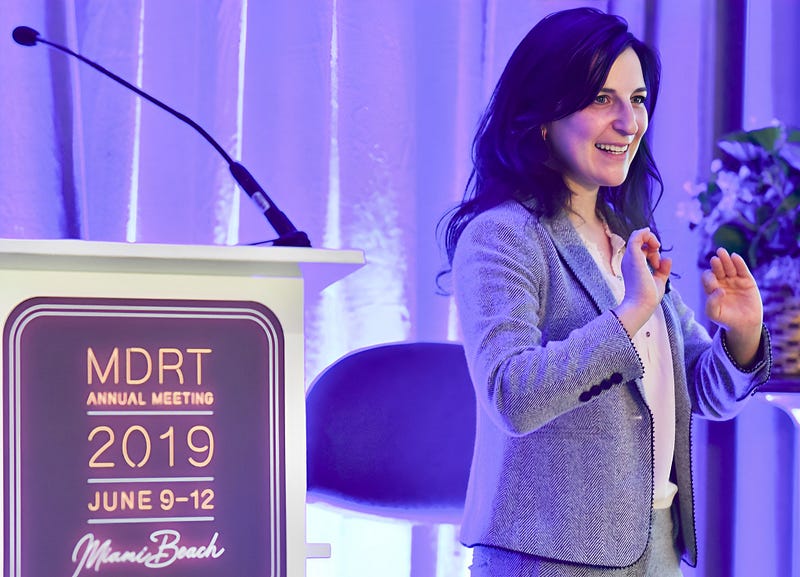Be kind. To everyone, all the time. You have no idea what they’re going through. And if you’re going through something, you’ll at least get kindness back when you need it most.
Quiet quitting is the emerging phenomenon of employee disengagement, essentially quitting on the job. What strategies do high-impact leaders deploy to motivate themselves and those around them to move from quiet quitting to quiet committing? Because, at its core, there is no change without commitment. Commitment to change ideas. Change beliefs. Change perspectives. Change routines, rituals and boundaries. Organizations change one commitment at a time. One leader at a time. As part of our series about “Quiet Committing: The Top Five Commitments High Impact Leaders Make & Keep To Themselves Daily”, we had the pleasure of interviewing Lois Weinblatt from True North Visionaries.
Lois Weinblatt is the founder of True North Visionaries and has been helping driven leaders use Visioning to gain clarity and improve decision-making for over 9 years. She’s worked with top CEOs and business strategists who want to gain clarity about what’s next for them. Lois has spoken to audiences of hundreds all over the world on the power of Visioning to create the exact future you want.
Thank you for making time for our visit. What was the first job you had, and how did that job shape the leader you are today?
I’ve been an entrepreneur since childhood summer camp. Instead of eating our daily allotment of candy, I saved mine up for the whole week. By Friday I’d have plenty of leverage to trade for higher-value items like stickers, keychains, and patches. Understanding how supply and demand affect pricing taught me to always price my products based on their true worth and value they create, and not to discount just because of market pressure.
We’re talking about quiet quitting in this series. What’s the greatest lesson you’ve learned from a job you decided to quit?
When I moved on from working at Zingerman’s Deli out of Ann Arbor, MI, I left with so much more than real-world food & retail experience. It was here I learned how powerful Visioning is for organizations, and applying those principles to my life helped me know when it was time to quit and start my own business. Trusting my intuition and believing in my Vision is why I am so committed to the business I’ve built over the last 9 years.
Employee Engagement is top of mind for most organizations. How do you define an engaged employee?
Engaged employees have an intrinsic motivation to do a great job, they work positively and proactively with others to get the job done well, and agrees with the mission and vision of the company.
Say more about your Employee Engagement portfolio. What’s working? What’s not working? And what are you piloting now to address the Quiet Committing trend?
I work with CEOs who want to create a compelling narrative of what a successful future looks like at their company. When the Vision is exciting, realistic, detailed, and optimistic, employees can get excited about it too. Genuine passion drives loyalty, and they feel like stakeholders in the mission of the company.
As goes the leadership, so goes the team. How do you hold leaders accountable for their own level of engagement?
Try:
1. Set clear expectations for what is expected from leaders. For example, being on time to all-hands meetings and defaulting to “video on”.
2. Provide feedback to understand what’s going on. There might be a reason for their lack of engagement that you can mitigate.
3. Model the behavior. Set an example by being engaged yourself. If leaders are not engaged, it will be difficult for others to follow their lead.
4. Create an employee Vision that allows them to see a future where they’re successfully growing in the company and role.
5. Address issues promptly. Provide additional training or coaching when needed so you don’t let issues fester too long.
The first phase of the pandemic ushered in the phenomenon called The Great Resignation, where employees left organizations to pursue greater meaning and purpose. Then came The Great Reshuffle, where employees left organizations to pursue promotions, pay and perks. Now we’ve entered a third phase, Quiet Quitting, where employees are deeply disengaged. What do you believe to be the key drivers of Quiet Quitting?
Burn out. People are just burned out after years of the pandemic requiring “above and beyond” commitments from so many employees. But remember that burn out is a result of too high of a workload, poor leadership, an uninspiring mission, or a toxic and unfair company culture. Address these issues and you won’t need perks to keep people around.
What do you predict will be the next phase in the evolution of the employer / employee landscape?
Long term career visioning that transcends companies. As the scales tip toward employees establishing healthier work-life balance, people want to see how their role fits into their whole life, and not the other way around. How will this role get me to where I want to go, and what if that’s not on your company’s linear career leveling list?
What leadership behaviors need to evolve to improve employee engagement in a sustainable way?
At the end of the day, people want to be treated fairly and paid well for a job well done. When you keep this basic arrangement sacred, the rest of of an engaged workforce culture can be set through foundational pillars of: Transparency, mentorship, feedback, and growth.

Change requires commitment and happens one choice at a time. What are the top five commitments you make and keep to yourself daily that have a material impact on those you lead?
1 . Be kind. To everyone, all the time. You have no idea what they’re going through. And if you’re going through something, you’ll at least get kindness back when you need it most.
2 . Define a Daily Vision. I use daily Visioning to feel successful every night, instead of behind with thoughts running. Sometimes it’s as small as, “I am laying in bed and I feel a little bit better than when I woke up.”
3 . Get enough sleep. It’s amazing how much better of a communicator, thinker, writer, coach, and mentor I become when I am rested.
4 . Reframe comparisonitis. You might not be able to stop yourself from comparing your situation to others. But as you recognize those thoughts, shift your thinking to remind yourself you’re doing your own thing and on your own journey.
5 . Baby steps. Some days, you are just taking one small step forward. And that’s okay!
What’s the most effective strategy you’ve discovered to get back on track when you break a commitment you’ve made?
Own it. Apologize if you need to, fix the issue, and show up on time the next time. The worst thing you can do after breaking a commitment, is to turn it into a pattern by making it easy to break another one. Be the accountable and engaged leader you want your team to be 🙂
Thank you for sharing these important insights. How can our readers further follow your work?
Please subscribe to my newsletter at truenorthvisionaries.com/visionary-fuel


